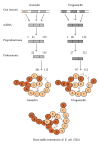Current understanding of guanylin peptides actions
- PMID: 24967239
- PMCID: PMC4045495
- DOI: 10.5402/2013/813648
Current understanding of guanylin peptides actions
Abstract
Guanylin peptides (GPs) family includes guanylin (GN), uroguanylin (UGN), lymphoguanylin, and recently discovered renoguanylin. This growing family is proposed to be intestinal natriuretic peptides. After ingestion of a salty meal, GN and UGN are secreted into the intestinal lumen, where they inhibit sodium absorption and induce anion and water secretion. At the same conditions, those hormones stimulate renal electrolyte excretion by inducing natriuresis, kaliuresis, and diuresis and therefore prevent hypernatremia and hypervolemia after salty meals. In the intestine, a well-known receptor for GPs is guanylate cyclase C (GC-C) whose activation increases intracellular concentration of cGMP. However, in the kidney of GC-C-deficient mice, effects of GPs are unaltered, which could be by new cGMP-independent signaling pathway (G-protein-coupled receptor). This is not unusual as atrial natriuretic peptide also activates two different types of receptors: guanylate cylcase A and clearance receptor which is also G-protein coupled receptor. Physiological role of GPs in other organs (liver, pancreas, lung, sweat glands, and male reproductive system) needs to be discovered. However, it is known that they are involved in pathological conditions like cystic fibrosis, asthma, intestinal tumors, kidney and heart failure, obesity, and metabolic syndrome.
Figures








Similar articles
-
Cellular effects of guanylin and uroguanylin.J Am Soc Nephrol. 2006 Mar;17(3):607-16. doi: 10.1681/ASN.2005080818. Epub 2005 Dec 28. J Am Soc Nephrol. 2006. PMID: 16382016 Review.
-
Mechanisms of actions of guanylin peptides in the kidney.Pflugers Arch. 2005 Aug;450(5):283-91. doi: 10.1007/s00424-005-1464-9. Epub 2005 Jun 11. Pflugers Arch. 2005. PMID: 15952032 Review.
-
Renal electrolyte effects of guanylin and uroguanylin.Curr Opin Nephrol Hypertens. 2007 Jan;16(1):10-5. doi: 10.1097/MNH.0b013e328011cb4a. Curr Opin Nephrol Hypertens. 2007. PMID: 17143065 Review.
-
Guanylin and uroguanylin induce natriuresis in mice lacking guanylyl cyclase-C receptor.Kidney Int. 2004 Jan;65(1):40-53. doi: 10.1111/j.1523-1755.2004.00375.x. Kidney Int. 2004. PMID: 14675035
-
Guanylin peptides: renal actions mediated by cyclic GMP.Am J Physiol Renal Physiol. 2000 Feb;278(2):F180-91. doi: 10.1152/ajprenal.2000.278.2.F180. Am J Physiol Renal Physiol. 2000. PMID: 10662722 Review.
Cited by
-
Effect of empagliflozin on circulating proteomics in heart failure: mechanistic insights into the EMPEROR programme.Eur Heart J. 2022 Dec 21;43(48):4991-5002. doi: 10.1093/eurheartj/ehac495. Eur Heart J. 2022. PMID: 36017745 Free PMC article. Clinical Trial.
-
Development of an enterotoxigenic Escherichia coli vaccine based on the heat-stable toxin.Hum Vaccin Immunother. 2019;15(6):1379-1388. doi: 10.1080/21645515.2018.1496768. Epub 2018 Aug 21. Hum Vaccin Immunother. 2019. PMID: 30081709 Free PMC article. Review.
-
Computational studies on the functional and structural impact of pathogenic mutations in enzymes.Protein Sci. 2025 Apr;34(4):e70081. doi: 10.1002/pro.70081. Protein Sci. 2025. PMID: 40116283 Review.
-
Metabolic responses to xenin-25 are altered in humans with Roux-en-Y gastric bypass surgery.Peptides. 2016 Aug;82:76-84. doi: 10.1016/j.peptides.2016.06.001. Epub 2016 Jun 7. Peptides. 2016. PMID: 27288245 Free PMC article. Clinical Trial.
-
Guanylate cyclase-C agonists as peripherally acting treatments of chronic visceral pain.Trends Pharmacol Sci. 2022 Feb;43(2):110-122. doi: 10.1016/j.tips.2021.11.002. Epub 2021 Dec 2. Trends Pharmacol Sci. 2022. PMID: 34865885 Free PMC article. Review.
References
-
- Lennane RJ, Peart WS, Carey RM, Shaw J. A comparison of natriuresis after oral and intravenous sodium loading in sodium depleted rabbits: evidence for a gastrointestinal or portal monitor of sodium intake. Clinical Science and Molecular Medicine. 1975;49(5):433–436. - PubMed
-
- Kita T, Kitamura K, Sakata J, Eto T. Marked increase of guanylin secretion in response to salt loading in the rat small intestine. American Journal of Physiology. 1999;277(5):G960–G966. - PubMed
-
- Greenberg RN, Hill M, Crytzer J, et al. Comparison of effects of uroguanylin, guanylin, and Escherichia coli heat-stable enterotoxin STa in mouse intestine and kidney: evidence that uroguanylin is an intestinal natriuretic hormone. Journal of Investigative Medicine. 1997;45(5):276–283. - PubMed
-
- Carrithers SL, Ott CE, Hill MJ, et al. Guanylin and uroguanylin induce natriuresis in mice lacking guanylyl cyclase-C receptor. Kidney International. 2004;65(1):40–53. - PubMed
Publication types
LinkOut - more resources
Full Text Sources
Other Literature Sources
Miscellaneous
